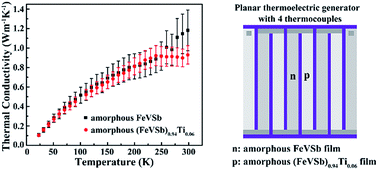FeVSb-based amorphous films with ultra-low thermal conductivity and high ZT: a potential material for thermoelectric generators†
Abstract
Amorphous FeVSb-based thin films doped with Ti are deposited by magnetron sputtering. The microstructure, thermal stability, and thermoelectric properties of the films are systematically investigated. The as-deposited (FeVSb)1−xTix films possess an amorphous structure that is thermally stable up to 473 K. The non-doped FeVSb film is an n-type semiconductor. When Ti is doped into the FeVSb film, the (FeVSb)1−xTix films with x from 0.02 to 0.10 are p-type semiconductors. The thermal conductivity values of the FeVSb and (FeVSb)0.94Ti0.06 films measured by the suspended thermal bridge method are 1.18 and 0.93 W m−1 K−1 at 300 K, respectively, which are much lower than those of half-Heusler crystalline bulk materials due to the amorphous structure of these films. The thermoelectric figure of merit ZT is calculated to be 0.09 and 0.23 at 300 K for the FeVSb and (FeVSb)0.94Ti0.06 films, respectively. A planar thermoelectric generator (TEG) with 4 thermocouples based on amorphous (FeVSb)1−xTix films is fabricated. The maximum output power and open-circuit voltage of the TEG are 248 nW and 15.4 mV at a temperature difference of 59.4 K. Our results demonstrate that the amorphous (FeVSb)1−xTix film with ultra-low thermal conductivity and high ZT at room temperature is a high-performance TE material for TEGs.



 Please wait while we load your content...
Please wait while we load your content...